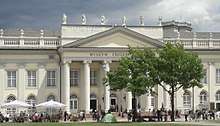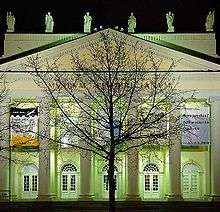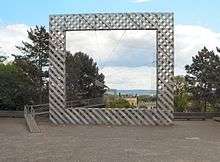documenta
documenta is an exhibition of contemporary art which takes place every five years in Kassel, Germany. It was founded by artist, teacher and curator Arnold Bode in 1955 as part of the Bundesgartenschau (Federal Horticultural Show) which took place in Kassel at that time,[1] and was an attempt to bring Germany up to speed with modern art, both banishing and repressing the cultural darkness of Nazism.[2] This first documenta featured many artists who are generally considered to have had a significant influence on modern art (such as Picasso and Kandinsky). The more recent documentas feature art from all continents; nonetheless most of it is site-specific.

Every documenta is limited to 100 days of exhibition, which is why it is often referred to as the "museum of 100 days".[3] Documenta is not a selling exhibition. It rarely coincides with the three other major art world events: the Venice Biennale, Art Basel and Skulptur Projekte Münster, but in 2017, all four were open simultaneously.
Etymology of documenta
The name of the exhibition is an invented word. The term is supposed to demonstrate the intention of every exhibition (in particular of the first documenta in 1955) to be a documentation of modern art which was not available for the German public during the Nazi era. Rumour spread from those close to Arnold Bode that it was relevant for the coinage of the term that the Latin word documentum could be separated into docere (Latin for teach) and mens (Latin for intellect) and therefore thought it to be a good word to describe the intention and the demand of the documenta.[4]
Each edition of documenta has commissioned its own visual identity, most of which have conformed to the typographic style of solely using lowercase letters, which originated at the Bauhaus.[5]
History

Art professor and designer Arnold Bode from Kassel was the initiator of the first documenta. Originally planned as a secondary event to accompany the Bundesgartenschau, this attracted more than 130,000 visitors in 1955. The exhibition centred less on "contemporary art“, that is art made after 1945: instead, Bode wanted to show the public works which had been known as "Entartete Kunst" in Germany during the Nazi era: Fauvism, Expressionism, Cubism, Blauer Reiter, Futurism and Pittura Metafisica. Therefore, abstract art, in particular the abstract paintings of the 1920s and 1930s, was the focus of interest in this exhibition.
Over time, the focus shifted to contemporary art. At first, the show was limited to works from Europe, but soon covered works by artists from the Americas, Africa and Asia. 4. documenta, the first ever to turn a profit, featured a selection of Pop Art, Minimal Art, and Kinetic Art.[6] Adopting the theme of Questioning Reality – Pictorial Worlds Today, the 1972 documenta radically redefined what could be considered art by featuring minimal and conceptual art, marking a turning point in the public acceptance of those styles.[7] Also, it devoted a large section to the work of Adolf Wolfli, the great Swiss outsider, then unknown. Joseph Beuys performed repeatedly under the auspices of his utopian Organization for Direct Democracy.[8] Additionally, the 1987 documenta show signaled another important shift with the elevation of design to the realm of art – showing an openness to postmodern design.[9] Certain key political dates for wide-reaching social and cultural upheavals, such as 1945, 1968 or 1976/77, became chronological markers of documenta X (1997), along which art's political, social, cultural and aesthetic exploratory functions were traced.[10] Documenta11 was organized around themes like migration, urbanization and the post-colonial experience,[11] with documentary photography, film and video as well as works from far-flung locales holding the spotlight.[7] In 2012, documenta (13) was described as "[a]rdently feminist, global and multimedia in approach and including works by dead artists and selected bits of ancient art".[12]
Criticism
documenta typically gives its artists at least two years to conceive and produce their projects, so the works are often elaborate and intellectually complex.[13] However, the participants are often not publicised before the very opening of the exhibition. At documenta (13), the official list of artists was not released until the day the show opened.[14] Even though curators have often claimed to have gone outside the art market in their selection, participants have always included established artists. In the documenta (13), for example, art critic Jerry Saltz identified more than a third of the artists represented by the renowned Marian Goodman Gallery in the show.[14]
Directors
The first four documentas, organized by Arnold Bode, established the exhibition's international credentials. Since the fifth documenta (1972), a new artistic director has been named for each documenta exhibition by a committee of experts. Documenta 8 was put together in two years instead of the usual five. The original directors, Edy de Wilde and Harald Szeemann, were unable to get along and stepped down. They were replaced by Manfred Schneckenburger, Edward F. Fry, Wulf Herzogenrath, Armin Zweite, and Vittorio Fagone.[15] Coosje van Bruggen helped select artists for documenta 7, the 1982 edition. documenta IX's team of curators consisted of Jan Hoet, Piero Luigi Tazzi, Denys Zacharopoulos, and Bart de Baere.[16] For documenta X Catherine David was chosen as the first woman and the first non-German speaker to hold the post. It is also the first and unique time that its website Documenta x was conceived by a curator (swiss curator Simon Lamunière) as a part of the exhibition. The first non-European director was Okwui Enwezor for Documenta11.[17]
The salary for the artistic director of documenta is around €100,000 a year.[18]
| Title | Date | Director | Exhibitors | Exhibits | Visitors |
|---|---|---|---|---|---|
| documenta | 16 July – 18 September 1955 | Arnold Bode | 148 | 670 | 130,000 |
| II. documenta | 11 July – 11 October 1959 | Arnold Bode, Werner Haftmann | 338 | 1770 | 134,000 |
| documenta III | 27 June – 5 October 1964 | Arnold Bode, Werner Haftmann | 361 | 1450 | 200,000 |
| 4. documenta | 27 June – 6 October 1968 | 24-strong documenta council | 151 | 1000 | 220,000 |
| documenta 5 | 30 June – October, 1972 | Harald Szeemann | 218 | 820 | 228,621 |
| documenta 6 | 24 June – 2 October 1977 | Manfred Schneckenburger | 622 | 2700 | 343,410 |
| documenta 7 | 19 June – 28 September 1982 | Rudi Fuchs | 182 | 1000 | 378,691 |
| documenta 8 | 12 June – 20 September 1987 | Manfred Schneckenburger | 150 | 600 | 474,417 |
| documenta IX | 12 June – 20 September 1992 | Jan Hoet | 189 | 1000 | 603,456 |
| documenta X | 21 June – 28 September 1997 | Catherine David | 120 | 700 | 628,776 |
| documenta11 | 8 June – 15 September 2002 | Okwui Enwezor | 118 | 450 | 650,924 |
| documenta 12 | 16 June – 23 September 2007 | Roger M. Buergel/Ruth Noack[19] | 114 | over 500 | 754,301 |
| documenta (13) | 9 June – 16 September 2012 | Carolyn Christov-Bakargiev | 187[20] | 904,992[21] | |
| documenta 14 | 8 April - 16 July 2017 in Athens, Greece; 10 June – 17 September 2017 in Kassel, Germany | Adam Szymczyk | |||
| documenta 15 | Sat, Jun 18, 2022 – Sun, Sep 25, 2022 in Kassel, Germany | ruangrupa [22] | |||
2012's edition was organized around a central node, the trans-Atlantic melding of two distinct individuals who first encountered each other in the "money-soaked deserts of the United Arab Emirates". As an organizing principle it is simultaneously a commentary on the romantic potentials of globalization and also a critique of how digital platforms can complicate or interrogate the nature of such relationships. Curatorial agents refer to the concept as possessing a "fricative potential for productive awkwardness," wherein a twosome is formed for the purposes of future exploration.[23]
Venues
documenta is held in different venues in Kassel. Since 1955, the fixed venue has been the Fridericianum. The documenta-Halle was built in 1992 for documenta IX and now houses some of the exhibitions. Other venues used for documenta have included the Karlsaue park, Schloss Wilhelmshöhe, the Neue Galerie, the Ottoneum, and the Kulturzentrum Schlachthof. Though Okwui Enezor notably tried to subvert the euro-centric approach documenta had taken, he instigated a series of five platforms before the Documenta11 in Vienna, Berlin, New Delhi, St Lucia, and Lagos, in an attempt to take documenta into a new post-colonial, borderless space, from which experimental cultures could emerge. documenta 12 occupied five locations, including the Fridericianum, the Wilhelmshöhe castle park and the specially constructed "Aue-Pavillon," or meadow pavilion, designed by French firm Lacaton et Vassal.[24] At documenta (13) (2012), about a fifth of the works were unveiled in places like Kabul, Afghanistan, and Banff, Canada.[13]
There are also a number of works that are usually presented outside, most notably in Friedrichsplatz, in front of the Fridericianum, and the Karlsaue park. To handle the number of artworks at documenta IX, five connected temporary "trailers" in glass and corrugated metal were built in the Karlsaue.[25] For documenta (13), French architects Anne Lacaton and Jean-Philippe Vassal constructed the temporary "Aue-Pavillon" in the park.

Permanent installations

A few of the works exhibited at various documentas remained as purchases in Kassel museums. They include 7000 Eichen by Joseph Beuys; Rahmenbau (1977) by Haus-Rucker-Co; Laserscape Kassel (1977) by Horst H. Baumann; Traumschiff Tante Olga (1977) by Anatol Herzfeld; Vertikaler Erdkilometer by Walter De Maria; Spitzhacke (1982) by Claes Oldenburg; Man walking to the sky (1992) by Jonathan Borofsky; and Fremde by Thomas Schütte (one part of the sculptures are installed on Rotes Palais at Friedrichsplatz, the other on the roof of the Concert Hall in Lübeck).
documenta archive
The extensive volume of material that is regularly generated on the occasion of this exhibition prompted Arnold Bode to create an archive in 1961. The heart of the archive’s collection comes from the files and materials of the documenta organization. A continually expanding video and image archive is also part of the collection as are the independently organized bequests of Arnold Bode and artist Harry Kramer.
Management
Visitors
In 1992, on the occasion of documenta IX, for the first time in the history of the documenta, more than half a million people traveled to Kassel.[26] The 2002 edition of documenta attracted 650,000 visitors, more than triple Kassel's population.[27] In 2007, documenta 12 drew 754,000 paying visitors, with more than one-third of the visitors coming from abroad and guests from neighboring Netherlands, France, Belgium and Austria among the most numerous.[28] In 2012, documenta (13) had 904,992 visitors.[21]
Budget
In 2007, half of documenta's budget of 19 million euros ($25.7 million) came from the city of Kassel, the state of Hessen and Germany's Kulturstiftung des Bundes. The rest came from sponsors, donors, and ticket sales.[29] Documenta 14’s budget was at 37 million euros ($40 million), spread between 2013 and 2018;[30] by the end of 2017, its deficit was expected to reach 5.4 million euros.[31] Overspending in Athens led to a liquidity shortfall of 7 million euros, forcing the shareholders of Documenta — the city of Kassel and the German state of Hesse — to step in with emergency loan guarantees worth 8 million euros.[31]
References
- Adrian Searle (June 11, 2012), "Documenta 13: Mysteries in the mountain of mud", The Guardian.
- Roberta Smith (June 14, 2012), Art Show as Unruly Organism The New York Times.
- Arnold Bode coined this phrase for the first time in the prologue of the first volume of the catalogue: documenta III. Internationale Ausstellung; Catalogue: Volume 1: Painting and Sculpture; Volume 2: Sketches; Volume 3: Industrial Design, Print; Kassel/Köln 1964; p. XIX
- Kimpel, Harald: documenta, Mythos und Wirklichkeit. Köln 1997, ISBN 3-7701-4182-2
- Alice Rawsthorn (June 3, 2012), A Symbol Is Born The New York Times.
- The documenta IV Exhibition in Kassel (1968) German History in Documents and Images (GHDI).
- Helen Chang (June 22, 2007), "Catching the Next Wave In Art at Documenta", The Wall Street Journal.
- Roberta Smith (September 7, 2007), "Documenta 5" The New York Times.
- Gimeno-Martinez, Javier; Verlinden, Jasmijn (2010). "From Museum of Decorative Arts to Design Museum: The Case of the Design museum Gent". Design and Culture. 2 (3).
- dX 1997, documenta XII.
- Stephan Valentin (June 12, 2007), An art show in Kassel, Germany, rivals Venice Biennale The New York Times.
- Roberta Smith (June 14, 2012), Art Show as Unruly Organism The New York Times.
- Kelly Crow (June 8, 2012), A Party, Every Five Years, for 750,000 Guests The Wall Street Journal.
- Jerry Saltz (June 15, 2012), Jerry Saltz: "Eleven Things That Struck, Irked, or Awed Me at Documenta 13" New York Magazine.
- Michael Brenson (June 15, 1987), "Documenta 8, Exhibition In West Germany", The New York Times.
- Michael Kimmelman (July 5, 1992) "At Documenta, It's Survival Of the Loudest", The New York Times.
- Jackie Wullschlager (May 19, 2012) Vertiginous doubt Financial Times.
- Julia Halperin, Gareth Harris (July 18, 2014) How much are curators really paid? Archived July 20, 2014, at the Wayback Machine The Art Newspaper.
- Holland Cotter (22 June 2007). "Asking Serious Questions in a Very Quiet Voice". The New York Times. Retrieved 2014-08-29.
- Ulrike Knöfel (8 June 2012). "What the 13th Documenta Wants You to See". Der Spiegel.
- "904,992 people visit documenta (13) in Kassel". documenta und Museum Fridericianum Veranstaltungs-GmbH. 16 September 2012. Archived from the original on 25 February 2014. Retrieved 8 August 2013.
- Russeth, Andrew (2019-02-22). "Ruangrupa Artist Collective Picked to Curate Documenta 15". ARTnews.com. Retrieved 2020-01-05.
- "In Germany, Disguising Documentary As Art". The Huffington Post. Retrieved 2015-09-28.
- Stephan Valentin (June 12, 2007), An art show in Kassel, Germany, rivals Venice Biennale International Herald Tribune.
- Roberta Smith (June 22, 1992), A Small Show Within an Enormous One The New York Times.
- d9 1992, documenta XII.
- Adrian Searle (June 19, 2007), 100 days of ineptitude The Guardian.
- Catherine Hickley (September 24, 2007), "Documenta Contemporary Art Show Draws Record 754,000 to Kassel", Bloomberg.
- Carly Berwick (May 17, 2007), "Documenta 'Mystery' Artists Are Revealed; Buzz Strategy Fizzles", Bloomberg.
- Rachel Donado (April 5, 2017), German Art Exhibition Documenta Expands Into Athens, The New York Times.
- Catherine Hickley (November 27, 2017), Documenta manager to leave post after budget overruns The Art Newspaper.
Further reading
- Nancy Marmer, "Documenta 8: The Social Dimension?" Art in America, Vol. 75, September 1987, pp. 128–138, 197–199.
External links
| Wikimedia Commons has media related to Documenta. |
| Wikivoyage has a travel guide for Kassel. |
- Official web page of the documenta
- Official archive of the documenta X
- City Panorama, interactive panorama at the Documenta Hall